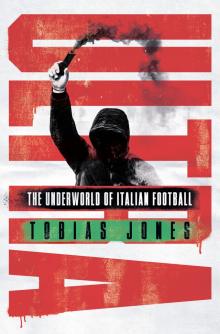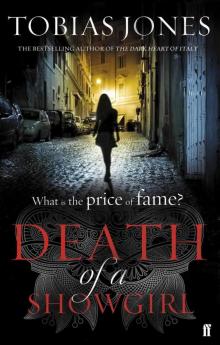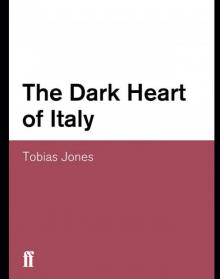- Home
- Tobias Jones
Ultra
Ultra Read online
AN APOLLO BOOK
www.headofzeus.com
This is an Apollo book, first published in the UK in 2019 by Head of Zeus Ltd
Copyright © Tobias Jones, 2019
IMAGE CREDITS:
Image 5 via Facebook, Image 6 via Il Romanista, Image 7 ANSA, Image 11 ANSA, Image 12 Getty / Matthew Ashton, Image 13 via Twitter
Other images are courtesy of Tobias Jones
Every effort has been made to credit the copyright owner of the images
Map © Jeff Edwards
Epigraph: Psalms 88:4
The moral right of Tobias Jones to be identified as the author of this work has been asserted in accordance with the Copyright, Designs and Patents Act of 1988.
All rights reserved. No part of this publication may be reproduced, stored in a retrieval system, or transmitted in any form or by any means, electronic, mechanical, photocopying, recording, or otherwise, without the prior permission of both the copyright owner and the above publisher of this book.
A catalogue record for this book is available from the British Library.
ISBN (HB): 9781786697363
ISBN (E): 9781786697356
Cover design: JAMES JONES
Cover image: WARREN WONG ON UNSPLASH
Head of Zeus Ltd
First Floor East
5–8 Hardwick Street
London EC1R 4RG
WWW.HEADOFZEUS.COM
Contents
Title Page
Copyright
Dedication
Epigraph
Author’s Note
Glossary
Map
Preface: Boxing Day, 2018
PART ONE
Present Day, Pescara: Siena v. Cosenza in the Lega-Pro (Serie C) Final
Ten months earlier, Cosenza (Casa degli Ultrà)
Present Day: Cosenza v. Paganese (Serie C)
1940s, Cosenza
Torino
Present Day: Matera v. Cosenza
1960s, Acri and Montagnola (Cosenza)
The Birth of the Ultras
Present Day: Reggina v. Cosenza
Mid-1970s, Turin
Present Day, Hotel Centrale, Cosenza
1977–78
1977–78, Cosenza
28 October 1979: Roma v. Lazio
Present Day, Cosenza
Early 1980s, Cosenza
1982: Violence
21 March 1982, Rome
1982, Cosenza
1982–83, Roma
8 February 1984, Trieste
1985, Cosenza
1986
December 1986, Central African Republic
1987, Drughi and Irriducibili
1987–88, Cosenza
28 January 1989
Present Day, Sambenedettese
1989, Genoa
4 June 1989, Milan
18 November 1989, Cosenza
Present Day, Sud-Tirol
Present Day: Siena v. Cosenza (Lega-Pro Final)
PART TWO
7 July 2016, Stura di Demonte
Present Day: Cosenza v. Verona
Early 1990s: Diabolik
12 September 1993, Cosenza
19 November 1994: Brescia v. Roma
29 January 1995, Genova
1996, Catania
Present Day, Carpi v. Cosenza
9 January 1998
24 May 1999: Piacenza v. Salernitana
2001, Piazza Alimondi, Genova
November 2002: Claudio arrested
2003, Genoa
21 March 2004, Rome: ‘The Derby of the Dead Baby
Present Day: Another Game
2005, Genoa
23 January 2006, Cosenza
February 2006: a Lazio take-over bid
2006: Eboli v. Cosenza
Present Day: Venezia v. Cosenza
2007, Cosenza
2 February 2007: Death of Filippo Raciti
11 November 2007, Arezzo
2011–12, Genoa
13 December 2011, Florence
22 April 2012, Genoa
Present Day: Verona v. Cosenza
February 2011
Present Day, Milano
3 May 2014: Coppa Italia Final
2014: Lucca–Luhansk
June 2015: Padre Fedele absolved
Present Day: Livorno v. Cosenza
2017–18, Fermo
Present Day: Another Game
Afterword
Plate Section
Acknowledgements
Select Bibliography
About the Author
An Invitation from the Publisher
The idea for this book was gifted to me by the great Jon Riley. I dedicate it to him, and to my sport-loving brother, Paul, and his family – Marija, Theodore and Kristian – with gratitude and admiration.
‘… ormai sono annoverato fra quelli che
scendono nella fossa…’
Author’s Note
Although I love football – playing it, watching it, talking about it – I’ve always thought the fans were more intriguing than the players. Maybe it’s an ideological inclination towards the masses rather than the elite; or else a belief that the meaning of sport resides not in the champions but in those who are being championed.
In many ways this isn’t a book about football at all, but a portrait of an enduring Italian subculture inspired by it. For over fifty years now, the ultras have turned the curve (the ‘curved’ ends behind the goal) into fairground mirrors of Italian society, offering both a reflection and a distortion of the country. The ultras are a fascinating way to understand not football as such, but why it means so much to people and why a mere rectangle of grass can inspire religious fundamentalism. They are often compared to punks, Hells Angels, hooligans or the South American Barras Bravas, and there are elements of all those groups within the evolving movement. But in truth, it’s a thoroughly Italian phenomenon drawing on much deeper influences within Italian history.
It is, though, the antithesis of a national movement. The foundation stone of every ultra group is topophilia (love of place) or campanilismo (the attachment to one’s local bell-tower). An ultra is a patriot of his or her patch, of a specific town, city or suburb. It’s about rootedness and belonging: the sort of pride that persuades people to boast that their forgotten nowhere is actually caput mundi, the ‘capital of the world’. Being an ultra is not simply about love for your own town or city, but hatred of the others, especially those close by or even in the same city.
That necessarily creates a problem for a writer attempting to trace the characteristics of a country-wide phenomenon: the ultra world is strangely incomprehensible if you look at it as a national movement, skating across the surface of hundreds of different groups. To do so has the same effect as to study colours (a key ultra concept) by mixing them all together and ending up with none. That’s why I decided to go deep into one particular setting. Whilst always keeping an eye on the national picture, I’ve concentrated on a small, ignored city in the deep South, trusting that the provincial can often be universal.
The choice of Cosenza requires a brief justification. Writers are, understandably, drawn to newsworthy events, and the ultras have always made the news. For decades they have been connected to murders, missing persons, bank jobs and drug-dealing, quite apart from the almost routine punch-ups and petty thefts that happen on match days. Yet those cronache nere – ‘black chronicles’ – are only partially representative of the ultra world. I actively sought out a curva, or terrace, which might balance the scales, which might even offer some ‘white chronicles’ as well. Cosenza, I had heard, was a place where the ultras squatted buildings confiscated from the Mafia, giving beds to hundreds of immigrants and destitute Italians. The Cosenza ultras had opened a foodbank for th
e poor and created Italy’s first play park for disabled children. One of the most influential fans in the curva was a Franciscan friar. In an era when so many terraces find inspiration in fascism, Cosenza remains devoutly anti-fascist. If anyone was looking for a place to find a counterbalance to the ultra stereotype, Cosenza was clearly it.
The more I went back, the more I felt that the city was an expression of the idealistic origins of the movement back in the late 1960s and early 1970s. It was playful, charitable, chaotic and spectacular. I often met Donata Bergamini, the sister of a Cosenza midfielder murdered in 1989, on the terraces. Thirty years after his death, she would be there in the rain with the ultras, supporting a team a thousand kilometres from her home near Ferrara. ‘I truly feel bad,’ she told me, ‘when I’m far from the city and its red-blue colours.’
And because Cosenza is a team that has never enjoyed much footballing or financial glory (it has bounced between the lower divisions of Serie D, C and B, going bust now and again), it doesn’t draw fans from across the country, let alone the globe. There’s no money to be made. Cosenza’s fans are decidedly local and, therefore, offer a far better insight into the rootedness, even poverty, of the ultras than do fans of more decorated teams. Ultras are implacably opposed to the robed dignitaries of modern football, and there was nowhere, I felt, more gloriously ragged than Cosenza.
I’ve concentrated on other teams and cities for reasons that will, hopefully, become obvious. One draw has, strangely, been grief. Passion is an integral part of fandom but much more so in its original sense of suffering. When human tragedies far surpass, whilst still reflecting, sporting ones, the ultras’ role becomes sacred, tending the memory of lives lost and mourned. Another reason I’ve been drawn to certain places was a hypothesis, possibly absurd, that ultra groups reflect their topography, so the more beguiling a city (like Genova or Catania) the more curious I was about their crews. I’ve been drawn to cities like Rome where there are local rivalries on the asphalt as much as there are on the grass. But I’m aware that many other famous groups (from Fiorentina, Napoli, Atalanta and elsewhere) are under-represented and I wouldn’t pretend that these pages are anything like exhaustive. Research has been skewed by my personal interests. Clubs with English and Welsh links, a capo-ultra with distant Hollywood connections, places with the best songs, supporters with the most unlikely yarns – on the long journey south to Cosenza I’ve often been led astray.
But I realize that I have also been drawn to ultra groups that help explain one of the most urgent topics of the early twenty-first century: the resurgence of far-right extremism. The ultras offer a unique vantage point to understand how and why fascism has re-emerged into the mainstream. As you go back through the years, it becomes obvious how hard certain ultras were rubbing the lamp before the genie reappeared. In many ways, the ultras of certain clubs anticipated, by decades, the rhetoric, methods and ideologies that are now dominating political discourse in Italy and elsewhere. If, occasionally, I seem to go off topic it’s because fascist revivalism is a constant subplot informing and polluting the ultra world.
There has also been a problem of veracity during research. Oral stories contain both richness and unreliability. I’ve often worried that the first evaporated in translation, then fretted that the second threatened truthfulness. The ultras have certain dates etched in their memory: Canaletta (‘Drainpipe’) has ‘338’ tattooed on his forearm (the number of away games he’s been to) along with ‘28/8/2016’ (the date of the match when Cosenza beat their local rivals, Catanzaro, 0–3). Many ultras are prouder of their recall than a preacher quoting the Good Book. But just as often they’ve forgotten when certain things happened, or confuse what they heard about with what they saw with their own eyes. They are incessant raconteurs, relishing and embellishing. For many of them, the last fifty years are a bit of a haze. If you ask them for a year, let alone a precise date, they often roll their eyes. I’ve been told a lot of stories that are hard to verify, and I’ve sadly had to edit out plenty of fine ones because of lack of proof or probability. But I’ve also chosen to repeat some stories that, just by their very existence, underline the legends that they live by. That’s not swapping accuracy for story telling, I hope, but offering glimpses of the stories the ultras tell themselves and joining dots where the only sources are ageing humans who have lived very hard.
I’ve also frequently quoted from ultra banners, the so-called striscioni. These curt couplets are how sometimes secretive groups present themselves – their cause, their stories and their controversies – to the world. That’s why they’ve been compared to Chinese dazibao, the posters used for quick communication. These blunt, invariably rhyming slogans appear at every game and are the distillation of hours of heated meetings. Although they are often superficial or extremist, they can also be witty, profound and thought-provoking. I wanted them to punctuate the text in the same way as they do the terraces.
Ultras reputedly abhor protagonismi (individual grandstanding) and many have legal travails and relational problems within their own terraces. Many only agreed to talk on condition of anonymity. I’ve duly left many unnamed, or else have rendered them unrecognizable by changing their names or nicknames. Others insisted I kept their true identity, so in the end there’s a mixture of real and invented appellations.
*
There’s inconsistency in Italian, let alone in English, about the spelling of ‘ultra’. In Italian, the word used to be accented: ultrà. Accented word endings are never normally pluralized in Italian (‘many cities’, for example, is molte città) and the word ultrà originally stood for both singular and plural. But because of their admiring nod to British fans and hooligans, ultrà groups have always loved anglicizations, and ultrà has often been pluralized to ultras. In academic discourse, some sociologists have used that pluralization (written ‘UltraS’, their upper case), to distinguish a new phalanx of extreme right-wing gangs that they consider separate to the traditionally apolitical groupings of ultrà. Often the singular is now used in Italian without an accent. How to render such variations in English is an unsettled question, so I’ve decided to keep it very simple: ‘ultra’ singular, ‘ultras’ plural, and no accent unless I’m using the word in Italian (as in ‘Casa degli Ultrà’). I’ve kept the names of football teams exactly as they appear in Italian even though that raises an inconsistency: because some teams were founded by the English and have English names (Genoa and Milan), I’ve left the name of those cities (Genova and Milano) in Italian in order to distinguish one from the other. I’ve remained loyal to team spellings elsewhere (Roma and Torino), so that their cities, for clarity, are actually anglicised (Rome and Turin). As is standard practice, I refer to Internazionale, the other team from Milano, as Inter, and Torino, sometimes, as Toro.
Glossary
CasaPound: a neo-fascist movement, named after Ezra Pound, founded in 2003.
Celtic cross: an encircled plus-sign, frequently used by the far right.
Curva: the (usually curved) terraces behind the goal that are the spiritual home of (almost all) ultras. Plural curve. Often distinguished by adding the points of the compass: Curva Nord (the north terrace), Curva Est (east), Curva Sud (south), and Curva Ovest (west). The word has taken on mythological depth: its rotundity leads people to give it a sense of pagan fertility (it’s a breast or womb), and its horse shoe shape suggests at an inclusivity towards the entire political spectrum.
Daspo: a stadium ban (from ‘Divieto di Accedere alle manifestazioni SPOrtive’), a measure introduced into law in December 1989. Bans can last up to eight years. The acronym often becomes a verb, daspare (‘to ban’), and an adjective, daspato (‘banned’).
Derby: a game between two teams within the same city, or else between two teams based in close proximity (Cosenza against Catanzaro, for example).
Diffidato: literally someone who has received an official warning. For simplicity I have translated it as ‘mistrusted’. It implies someone banned from stadiums.
/>
Duce / Dux: a cognate of ‘duke’ and ‘doge’, it means ‘leader’, ‘warlord’ or ‘guide’. An appellation orginally used to compliment Giuseppe Garibaldi and Gabriele D’Annunzio, it is now associated solely with Benito Mussolini.
Fascism: notoriously hard to define, it was the name given to the totalitarian movement founded by Benito Mussolini. The ‘fascia’ was the binding of an axe within rods, the original symbol of the lictors, the officers of ancient Rome. It implied strength in unity, and the protruding blade implied the power of life or death over subjects. Michael Mann defined fascism as ‘the pursuit of a transcendent and cleansing nation-statism through paramilitarism’. Robert Paxton called it: ‘… a form of political behaviour marked by obsessive preoccupation with community decline, humiliation, or victimhood and by compensatory cults of unity, energy, and purity, in which a mass-based party of committed nationalist militants, working in uneasy but effective collaboration with traditional elites, abandons democratic liberties and pursues, with redemptive violence and without ethical or legal restraints, goals of internal cleansing and external expansion’.
FIGC: the ‘Federazione italiana giuoco calcio’. The Italian Football Association.
Forza Nuova: A neo-fascist party founded in 1997 by Roberto Fiore and Massimo Morsello.
Fossa: the ‘pit’ or ‘ditch’, but also implying the trenches, the grave and hell. A common name for ultra groups in the early days.
Goliardia: high spirits, transgression, satire or fun-and-games. A word invariably used by ultras to describe their excesses.
Gradinata: literally a ‘flight of steps’ or a ‘staircase’. Sometimes used to describe the terraces. Genoa’s Gradinata Nord is the most famous.
Lupi: Wolves (used to describe the players, or fans, of Roma and Cosenza, amongst others)
Maglia: the shirt. An object of mystical reverence.
Mentalità: the ‘mentality’. Frequently invoked to suggest that there is a unique mindset to being an ultra.
Movimento Sociale Italiano-Destra Nazionale: the Italian Social Movement-National Right, usually known as the MSI. Founded in 1946 and dissolved in 1995, it was Italy’s post-war fascist party.

 Ultra
Ultra The Salati Case
The Salati Case Death of a Showgirl
Death of a Showgirl The Dark Heart of Italy
The Dark Heart of Italy